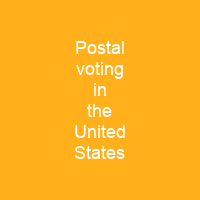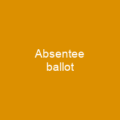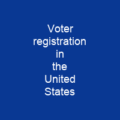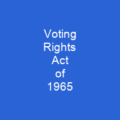Postal voting is a form of absentee ballot in the United States. A ballot is mailed to the home of a registered voter, who fills it out and returns it by postal mail or drops it off in-person into a secure drop box or at a voting center. Research shows that the availability of postal voting increases voter turnout.
About Postal voting in the United States in brief

One study found the in person voting in Wisconsin in April 2020 did not produce a detectable surge in American-risk activity, and rated it as a low-risk, low-cost option. The Help America Vote Act requires some polling options, often at central election headquarters, with voting machines designed for disabled people. Some states let voters with permanent disabilities apply for permanent absentee voter status, and some other states let all citizens apply for Permanent absentee ballot for each election. In September 2020, CNN obtained a Homeland Security Department intelligence bulletin asserting that Russia is likely to continue amplifying criticisms of vote- by-mail and shifting voting processes amidst the CO VID-19 Pandemic to undermine public trust in the electoral process. Some jurisdictions used only absentee votes for the coronavirus pandemic, during lock-downs for the 2020 US presidential election, but 87% of Democrats and 49% of Republicans supported this measure. In fact, in most jurisdictions, all valid absentee ballots are counted even if they if they will not affect the outcome of an election. In some states, ballots may be sent by the Postal Service without prepayment of postage. All-mail elections can save money, while a mix of voting options can cost more. Vote by mail is available in both red and blue states.
You want to know more about Postal voting in the United States?
This page is based on the article Postal voting in the United States published in Wikipedia (as of Dec. 06, 2020) and was automatically summarized using artificial intelligence.







